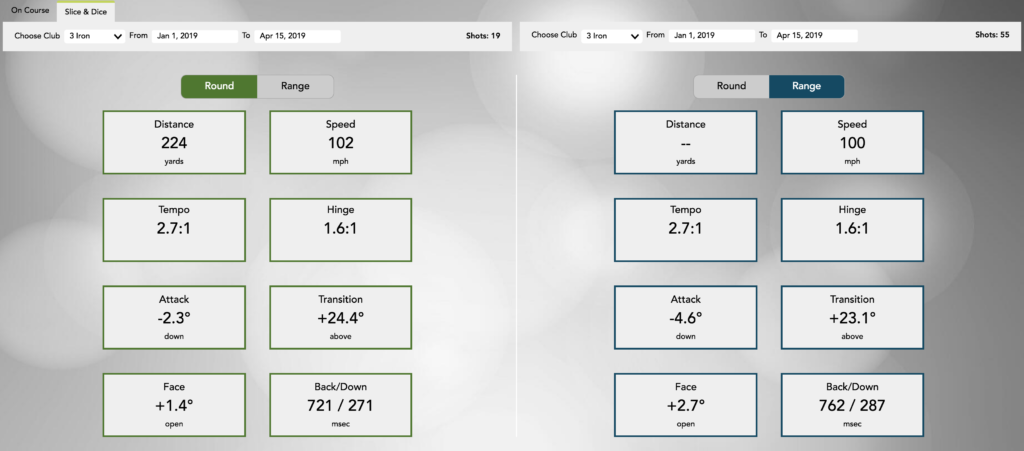theHub: Slice & Dice Analytics
If you are familiar with the On Course section of theHub’s Analytics tools from last month’s blog post, it’s time to learn the ins and outs of the second Analytics section: Slice & Dice.
Slice & Dice includes your practice tee performance and your round results to give you a comprehensive view of your game. This unique insight is only available with ClubHub because it is the only portable sensor system that captures swing analytics on course and at the range.
Why Slice & Dice?
The name Slice & Dice did not come about because we thought some cooking advice could help your golf game. The funky name best depicts the ways this new feature allows you to compare differences in your performance on the range and course to reveal where improvement is happening and what needs the most work. Whether you have questions about season to season differences, results of a new swing change, your club head speed during range sessions compared to your rounds, your 3 Wood compared to your Driver, etc., you can examine all of it in Slice & Dice Analytics.
Make it a Combo

There are two sections that have a menu where you can choose shots by date range, club type, and event type (range or round). Once the shot sections are set, a shot count will appear in the top right side of each menu and two sets of parameters will populate below. The parameters are averages of all the full swing shots you took with the selected club within the selected date range. Non-full swings are not factored in to show you a true representation of how you are hitting each club.
Date Range 1 vs Date Range 2: Compare the same club, same event type (range-range or round-round), but set two different date ranges. This could be the prior month compared to the current month, last season compared to this season, or even last week compared to this week. You can choose your time window based on how frequently you play and when you are tweaking your swing. This method will help both instructors and players monitor progress and identify more effective swing adjustments.
Range vs Round: Compare the same club, with the same date range, but select Range for one side and Round for the other. Anxiety and distraction can affect you on the course. Do you have a deeper transition angle and faster club head speed at the range? Or perhaps you notice faster backswing and downswing times during your rounds because you are rushing your swing. Take note of your range stats when you have it dialed-in and try to aim for those numbers the next time you are on the course to keep your nerves from getting the better of you.
Club vs Club: Set the same date range, select the same event type, but pick two different clubs. Select a favorite club and one you just can’t seem to hit and check the parameters of each. Your troublesome club may become your new best friend. Club comparisons can help you better your on-course club selections by making you more familiar with what kinds of results you are getting from each club. It can also help you realize what you need to practice more at the range.
Potpourri: Maybe you want to compare how you are hitting with your 3 Wood at the range versus how you are hitting your Driver on the course to determine if you should be teeing off with a different club. Or you want to show your instructor that you have been working on increasing your transition angle with your irons from last month to this month. That is the beauty of this analytics tool because you can customize every part of it to fit your needs.
Trends

Under each set of parameters, you will see a graph with a dropdown menu that lets you focus on a single parameter. The parameter you select will be for the club chosen at the top of the page, within the selected date range, and for the specified event type. This graph provides a view of how the chosen parameter has trended over time. Here you can see if your performance is steady, erratic, improving, or declining.
The Trends section is where players and instructors can see how parameters affect others. You can see your how your club head speed is trending compared to your distance with any club. Are they both going up or is your increased club head speed causing you to lose distance? Does a lower hinge value cause your speed to trend upward? Are you gaining more distance when you have a more positive angle of attack with your driver? All of these questions can be answered by examining the different trend comparisons.
We are confident that this Analytics section can help you answer many questions you have about your game. Try it for yourself with the 30-day free trial or sign up for a monthly or annual subscription and find the answers to your game improvement. If you have any questions about your analytics, feel free to ask the experts and send us an email at info@kineteksports.com.
Leave a Reply